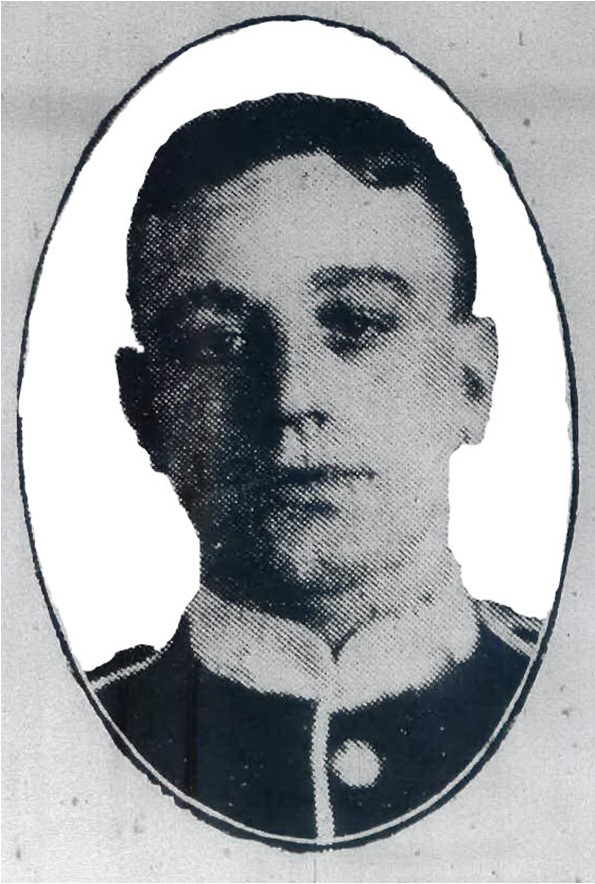
John William Ellis (1886-1915)
John William Ellis was born in January 1886, of three brothers. All three were to join the armed services. John and Joseph joined the Army and George the Royal Navy.
John originally enlisted on 4 June 1904, at Grantham, into the 4th Battalion Lincolnshire Regiment. He signed up for the post-Boer War 3 years with the colours and 9 years in the Reserve. Being just 18 years and four months old he stood 5 feet 3 inches tall. He had a fresh complexion, grey eyes and brown hair, with slightly bowed legs.
He extended his service to complete nine years with the colours in 1906 after being medically examined and declared fit for service. In May 1906 John subsequently transferred to the 1st Battalion Leicestershire Regiment.
John landed in India February 1906. He was stationed at Kamplee and Belgaum. When the 2nd Leicesters’ Battalion arrived in October to relieve the 1st Battalion John transferred to the 2nd Battalion and stayed on in India. The 2nd Battalion was judged to be “best regiment at arms” at the 6th Divisional “Assault at Arms” held at Poona, February 1908. Whilst at Belguam, July to October 1908, John was hospitalised for 80 days with Enteric Fever. It was a moderately severe case and he was excused duty for a whole month.
During 1909 the Battalion won the 6th Divisional shooting trophy. In July the Battalion ‘was awarded the “Marcks” shield for the best shooting regiment in the Southern Army’. The headquarters and right half Battalion left Belgaum in February 1911 by train and took up quarters at Fort St. George, Madras, some two days later. Much of the Battalion’s time was taken up with sports of all kinds: football, rugby, hockey, cricket, boxing, cross-country and billiards. The last record of John being in Madras is dated April 1912.
Upon return to England John was transferred to the Military Reserve on 21 December 1912. He married Lillie May Loughland at the Grantham Register Office, on 8 February 1913. Lillie and John soon cemented their marriage and had a son, George William, who was born on 30 November 1913.
War was declared on 4 August 1914. John joined the 1st Leicesters, D Company, on 5 August 1914 at Glen Parva barracks, Leicester. The reservists were quickly entrained for Fermoy, Ireland, where the 1st battalion was stationed. John and the other reservists arrived on 9 August. However, by 14 August the Battalion was on the move, travelling to England via Holyhead.
They joined the 6th Division based around Cambridge and Newmarket on 19 August at a camp on Coldham Common. Here training was resumed and all three Brigades of the Division (16th, 17th and 18th Infantry Brigades) came together. On 27 August the Division moved to Grantchester and stayed there for ten days. The final reservists replaced men unfit for combat.
On 7 September embarkation orders were received. At Southampton they boarded the Braemar Castle. The Leicesters landed at St Nazaire, on 10 September, after being at seas for two days. The Division endured a long train journey arriving at Mortcerf, East of Paris, early in the morning of 13 September. Here the Division was billeted. A long march then commenced to the Aisne.
On the afternoon of the 20 September the 6th Division reached the British Army in the line, at Courcelles as they were digging in, on the far side of the River Aisne. The Division immediately relieved troops that had been fighting since the retreat from Mons and the Battles of the Marne and the Aisne. On 21 September 1st Leicester relieved the Worcesters and Royal Irish Rifles in the trenches at La Fosse Marguel. They suffered from enemy shell fire and sniping.
Chocolates and cigarettes were issued to the men on 6 October. The following day they were given a blanket per man as the nights were now terribly cold.
After being in the trenches for nine weeks, on the evening of 12/13 October the 106th French Infantry relieved the 1st Leicesters. On 13 October the Battalion entrained at Fismes. A 30 hour train journey took them past Paris, branching off to St. Denis, Etaples and Boulogne. The men were crammed 40 to each horse box. Some brave souls slept on the roof. They disentrained at Cassel and marched to Oultersteene, Cruseobeau taking up defensive positions at Croix Blanch on 17 October.
16th Infantry Brigade rejoined the Division from the Aisne on 18 October. A push was ordered and Radinghem was captured and then retaken by the Germans. The Brigades of 6th Division held positions from Radinghem to Ennetieres and thence from Premesque to Epinette.
The Leicesters were in defensive positions at Croix Blanche and then Rue Du Bois where it relieved the West Yorkshire Regiment, in the line at the Chemical Factory, under repeated attacks and continuous enfilade gun fire. They suffered from heavy artillery and machine gun fire and were counterattacked.
The German artillery was able to dominate the battlefield and it brought this considerable weight of fire onto the heads of the British infantry, along the entire front. The BEF was heavily outnumbered and outgunned.
On 22 October the Leicesters were dug in about La Houssoie, they were heavily shelled with shrapnel and heavy howitzers all day. 13 men were killed and 25 wounded. The following day, 23 October, the Battalion was again heavily shelled. The Germans attacked at dawn and again at 4.30pm. Both attacks were repulsed and beaten off.
However, seven men were killed and 22 wounded. Sadly one of the fatal casualties was John Ellis. He was just 29 and left a widow and child just eleven months old.




Leave a Reply
You must be logged in to post a comment.